Mental Health Examination and Recovery
VerifiedAdded on 2023/01/05
|7
|2254
|59
AI Summary
This document discusses the components of a mental health examination, including level of consciousness, physical appearance and behavior, perception or thought, and language and cognitive abilities. It also explores the Diagnostic and Statistical Manual of Mental Disorders (DSM) and its role in understanding mental disorders. Additionally, the document examines the stress-vulnerability model and its impact on mental health. Finally, it discusses recovery-oriented mental health practice and the importance of creating an environment that supports individuals in overcoming mental illness.
Contribute Materials
Your contribution can guide someone’s learning journey. Share your
documents today.
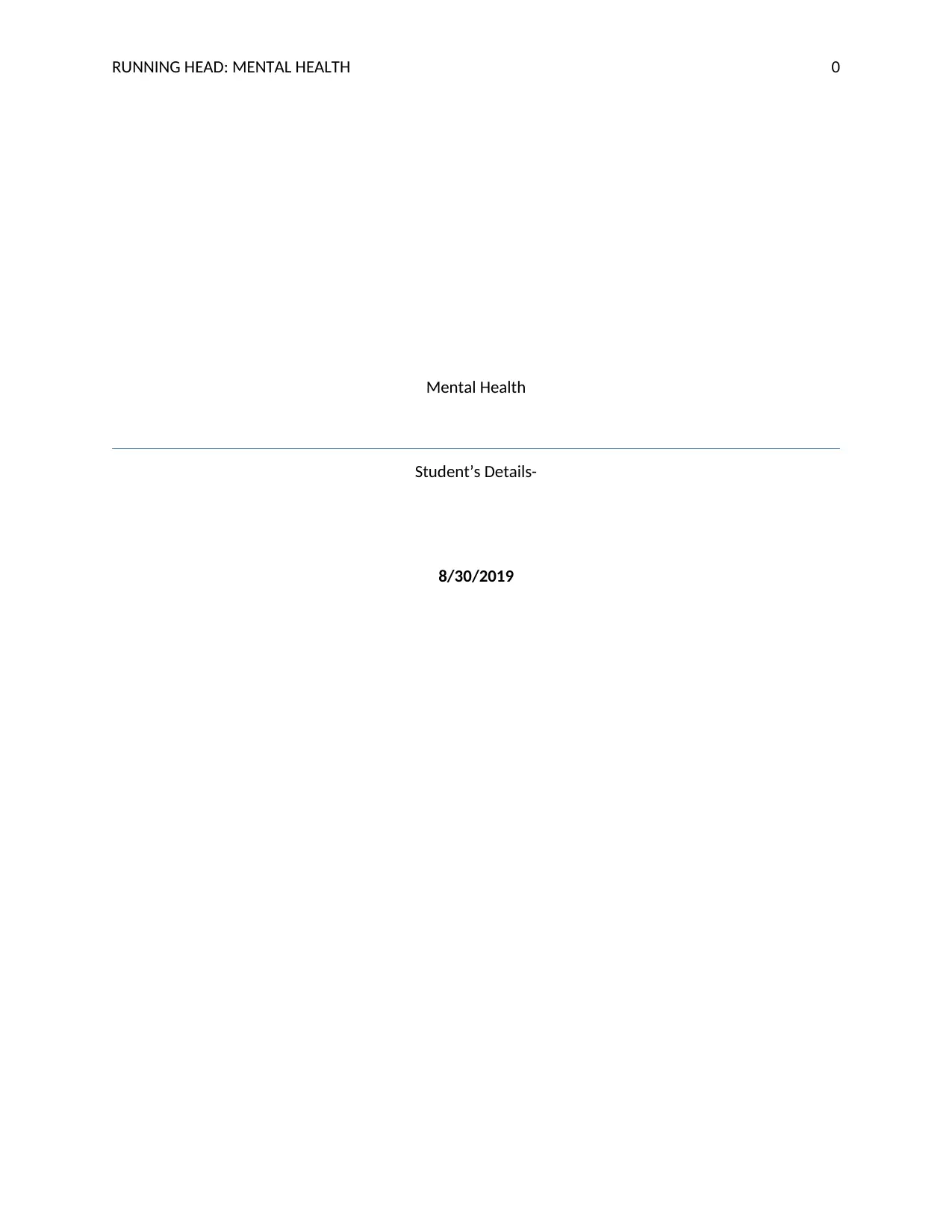
RUNNING HEAD: MENTAL HEALTH 0
Mental Health
Student’s Details-
8/30/2019
Mental Health
Student’s Details-
8/30/2019
Secure Best Marks with AI Grader
Need help grading? Try our AI Grader for instant feedback on your assignments.
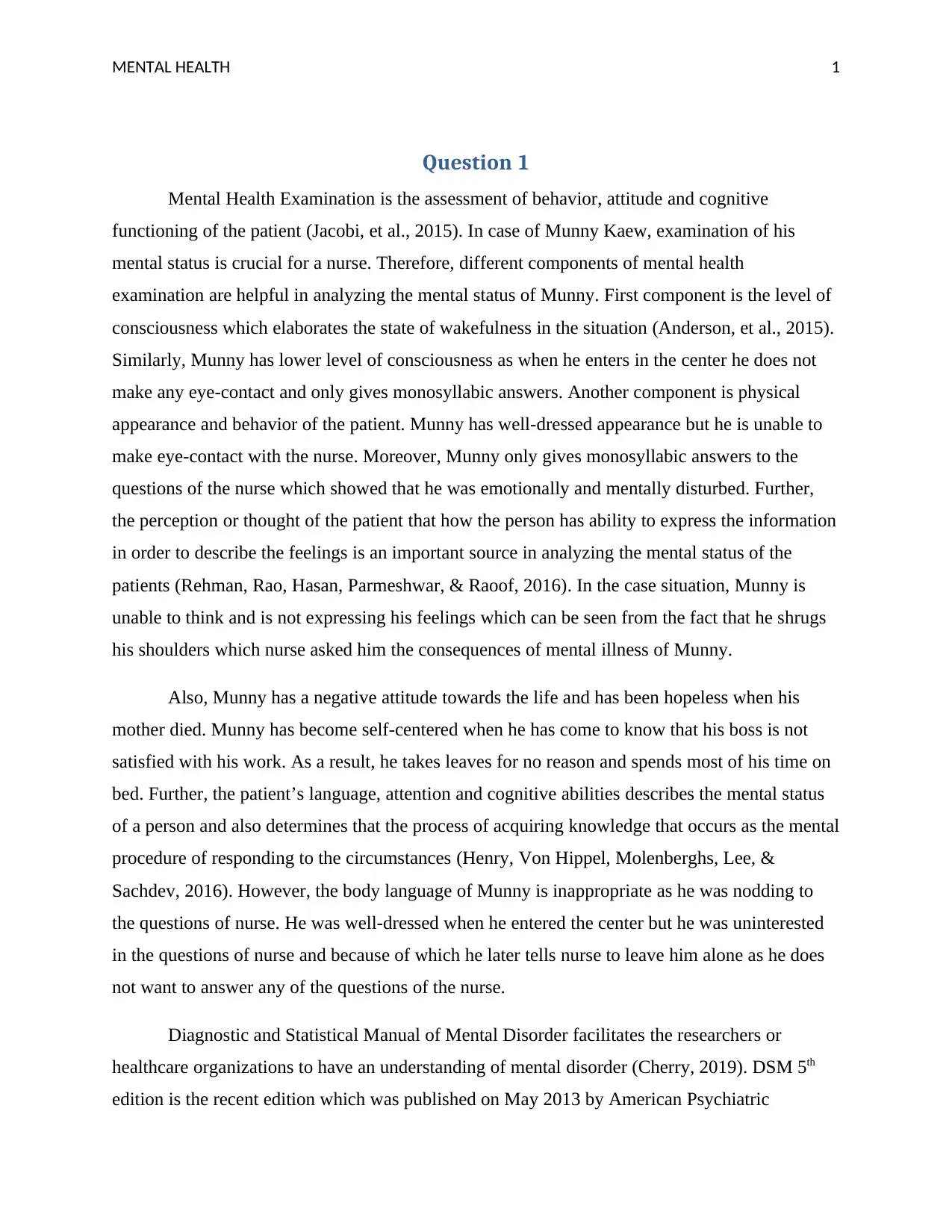
MENTAL HEALTH 1
Question 1
Mental Health Examination is the assessment of behavior, attitude and cognitive
functioning of the patient (Jacobi, et al., 2015). In case of Munny Kaew, examination of his
mental status is crucial for a nurse. Therefore, different components of mental health
examination are helpful in analyzing the mental status of Munny. First component is the level of
consciousness which elaborates the state of wakefulness in the situation (Anderson, et al., 2015).
Similarly, Munny has lower level of consciousness as when he enters in the center he does not
make any eye-contact and only gives monosyllabic answers. Another component is physical
appearance and behavior of the patient. Munny has well-dressed appearance but he is unable to
make eye-contact with the nurse. Moreover, Munny only gives monosyllabic answers to the
questions of the nurse which showed that he was emotionally and mentally disturbed. Further,
the perception or thought of the patient that how the person has ability to express the information
in order to describe the feelings is an important source in analyzing the mental status of the
patients (Rehman, Rao, Hasan, Parmeshwar, & Raoof, 2016). In the case situation, Munny is
unable to think and is not expressing his feelings which can be seen from the fact that he shrugs
his shoulders which nurse asked him the consequences of mental illness of Munny.
Also, Munny has a negative attitude towards the life and has been hopeless when his
mother died. Munny has become self-centered when he has come to know that his boss is not
satisfied with his work. As a result, he takes leaves for no reason and spends most of his time on
bed. Further, the patient’s language, attention and cognitive abilities describes the mental status
of a person and also determines that the process of acquiring knowledge that occurs as the mental
procedure of responding to the circumstances (Henry, Von Hippel, Molenberghs, Lee, &
Sachdev, 2016). However, the body language of Munny is inappropriate as he was nodding to
the questions of nurse. He was well-dressed when he entered the center but he was uninterested
in the questions of nurse and because of which he later tells nurse to leave him alone as he does
not want to answer any of the questions of the nurse.
Diagnostic and Statistical Manual of Mental Disorder facilitates the researchers or
healthcare organizations to have an understanding of mental disorder (Cherry, 2019). DSM 5th
edition is the recent edition which was published on May 2013 by American Psychiatric
Question 1
Mental Health Examination is the assessment of behavior, attitude and cognitive
functioning of the patient (Jacobi, et al., 2015). In case of Munny Kaew, examination of his
mental status is crucial for a nurse. Therefore, different components of mental health
examination are helpful in analyzing the mental status of Munny. First component is the level of
consciousness which elaborates the state of wakefulness in the situation (Anderson, et al., 2015).
Similarly, Munny has lower level of consciousness as when he enters in the center he does not
make any eye-contact and only gives monosyllabic answers. Another component is physical
appearance and behavior of the patient. Munny has well-dressed appearance but he is unable to
make eye-contact with the nurse. Moreover, Munny only gives monosyllabic answers to the
questions of the nurse which showed that he was emotionally and mentally disturbed. Further,
the perception or thought of the patient that how the person has ability to express the information
in order to describe the feelings is an important source in analyzing the mental status of the
patients (Rehman, Rao, Hasan, Parmeshwar, & Raoof, 2016). In the case situation, Munny is
unable to think and is not expressing his feelings which can be seen from the fact that he shrugs
his shoulders which nurse asked him the consequences of mental illness of Munny.
Also, Munny has a negative attitude towards the life and has been hopeless when his
mother died. Munny has become self-centered when he has come to know that his boss is not
satisfied with his work. As a result, he takes leaves for no reason and spends most of his time on
bed. Further, the patient’s language, attention and cognitive abilities describes the mental status
of a person and also determines that the process of acquiring knowledge that occurs as the mental
procedure of responding to the circumstances (Henry, Von Hippel, Molenberghs, Lee, &
Sachdev, 2016). However, the body language of Munny is inappropriate as he was nodding to
the questions of nurse. He was well-dressed when he entered the center but he was uninterested
in the questions of nurse and because of which he later tells nurse to leave him alone as he does
not want to answer any of the questions of the nurse.
Diagnostic and Statistical Manual of Mental Disorder facilitates the researchers or
healthcare organizations to have an understanding of mental disorder (Cherry, 2019). DSM 5th
edition is the recent edition which was published on May 2013 by American Psychiatric
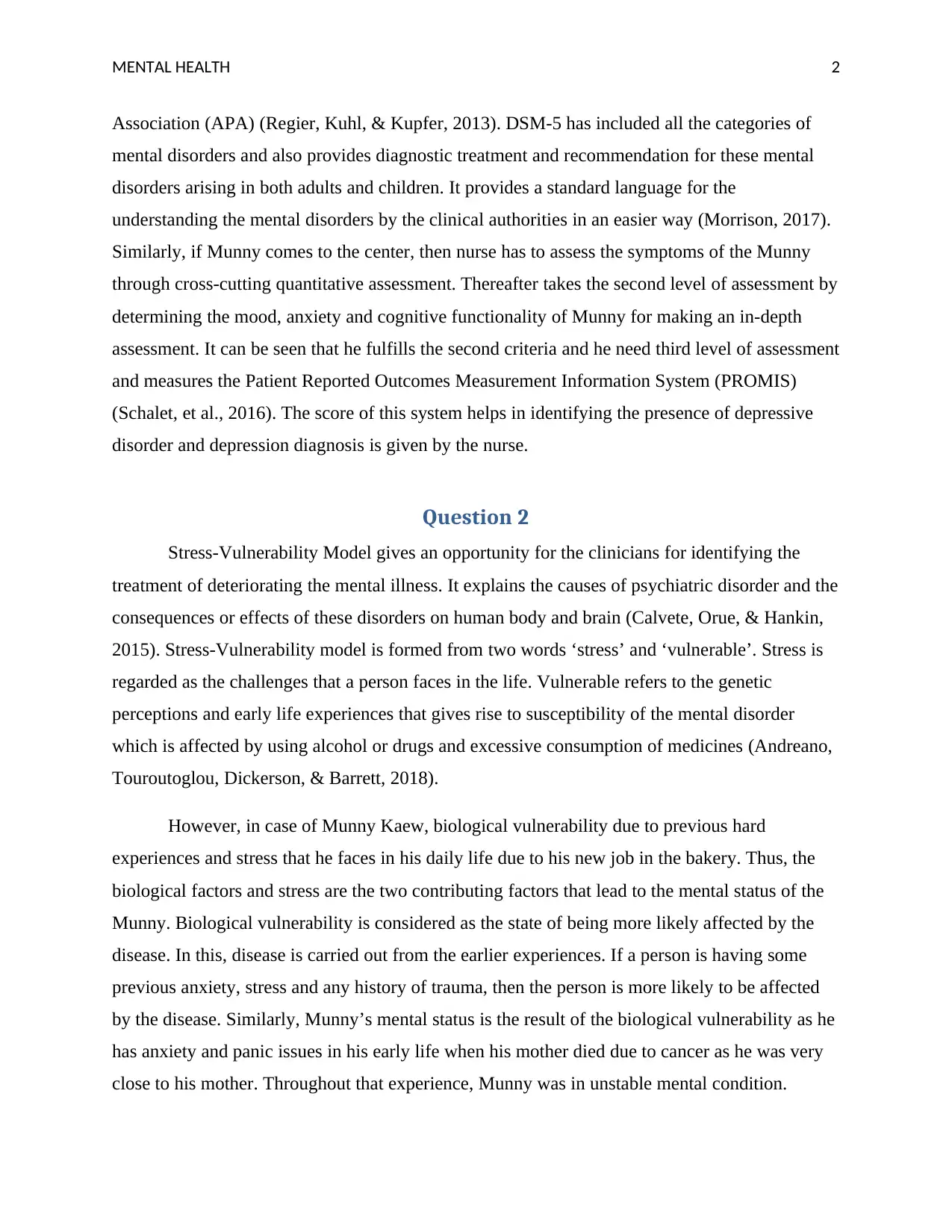
MENTAL HEALTH 2
Association (APA) (Regier, Kuhl, & Kupfer, 2013). DSM-5 has included all the categories of
mental disorders and also provides diagnostic treatment and recommendation for these mental
disorders arising in both adults and children. It provides a standard language for the
understanding the mental disorders by the clinical authorities in an easier way (Morrison, 2017).
Similarly, if Munny comes to the center, then nurse has to assess the symptoms of the Munny
through cross-cutting quantitative assessment. Thereafter takes the second level of assessment by
determining the mood, anxiety and cognitive functionality of Munny for making an in-depth
assessment. It can be seen that he fulfills the second criteria and he need third level of assessment
and measures the Patient Reported Outcomes Measurement Information System (PROMIS)
(Schalet, et al., 2016). The score of this system helps in identifying the presence of depressive
disorder and depression diagnosis is given by the nurse.
Question 2
Stress-Vulnerability Model gives an opportunity for the clinicians for identifying the
treatment of deteriorating the mental illness. It explains the causes of psychiatric disorder and the
consequences or effects of these disorders on human body and brain (Calvete, Orue, & Hankin,
2015). Stress-Vulnerability model is formed from two words ‘stress’ and ‘vulnerable’. Stress is
regarded as the challenges that a person faces in the life. Vulnerable refers to the genetic
perceptions and early life experiences that gives rise to susceptibility of the mental disorder
which is affected by using alcohol or drugs and excessive consumption of medicines (Andreano,
Touroutoglou, Dickerson, & Barrett, 2018).
However, in case of Munny Kaew, biological vulnerability due to previous hard
experiences and stress that he faces in his daily life due to his new job in the bakery. Thus, the
biological factors and stress are the two contributing factors that lead to the mental status of the
Munny. Biological vulnerability is considered as the state of being more likely affected by the
disease. In this, disease is carried out from the earlier experiences. If a person is having some
previous anxiety, stress and any history of trauma, then the person is more likely to be affected
by the disease. Similarly, Munny’s mental status is the result of the biological vulnerability as he
has anxiety and panic issues in his early life when his mother died due to cancer as he was very
close to his mother. Throughout that experience, Munny was in unstable mental condition.
Association (APA) (Regier, Kuhl, & Kupfer, 2013). DSM-5 has included all the categories of
mental disorders and also provides diagnostic treatment and recommendation for these mental
disorders arising in both adults and children. It provides a standard language for the
understanding the mental disorders by the clinical authorities in an easier way (Morrison, 2017).
Similarly, if Munny comes to the center, then nurse has to assess the symptoms of the Munny
through cross-cutting quantitative assessment. Thereafter takes the second level of assessment by
determining the mood, anxiety and cognitive functionality of Munny for making an in-depth
assessment. It can be seen that he fulfills the second criteria and he need third level of assessment
and measures the Patient Reported Outcomes Measurement Information System (PROMIS)
(Schalet, et al., 2016). The score of this system helps in identifying the presence of depressive
disorder and depression diagnosis is given by the nurse.
Question 2
Stress-Vulnerability Model gives an opportunity for the clinicians for identifying the
treatment of deteriorating the mental illness. It explains the causes of psychiatric disorder and the
consequences or effects of these disorders on human body and brain (Calvete, Orue, & Hankin,
2015). Stress-Vulnerability model is formed from two words ‘stress’ and ‘vulnerable’. Stress is
regarded as the challenges that a person faces in the life. Vulnerable refers to the genetic
perceptions and early life experiences that gives rise to susceptibility of the mental disorder
which is affected by using alcohol or drugs and excessive consumption of medicines (Andreano,
Touroutoglou, Dickerson, & Barrett, 2018).
However, in case of Munny Kaew, biological vulnerability due to previous hard
experiences and stress that he faces in his daily life due to his new job in the bakery. Thus, the
biological factors and stress are the two contributing factors that lead to the mental status of the
Munny. Biological vulnerability is considered as the state of being more likely affected by the
disease. In this, disease is carried out from the earlier experiences. If a person is having some
previous anxiety, stress and any history of trauma, then the person is more likely to be affected
by the disease. Similarly, Munny’s mental status is the result of the biological vulnerability as he
has anxiety and panic issues in his early life when his mother died due to cancer as he was very
close to his mother. Throughout that experience, Munny was in unstable mental condition.
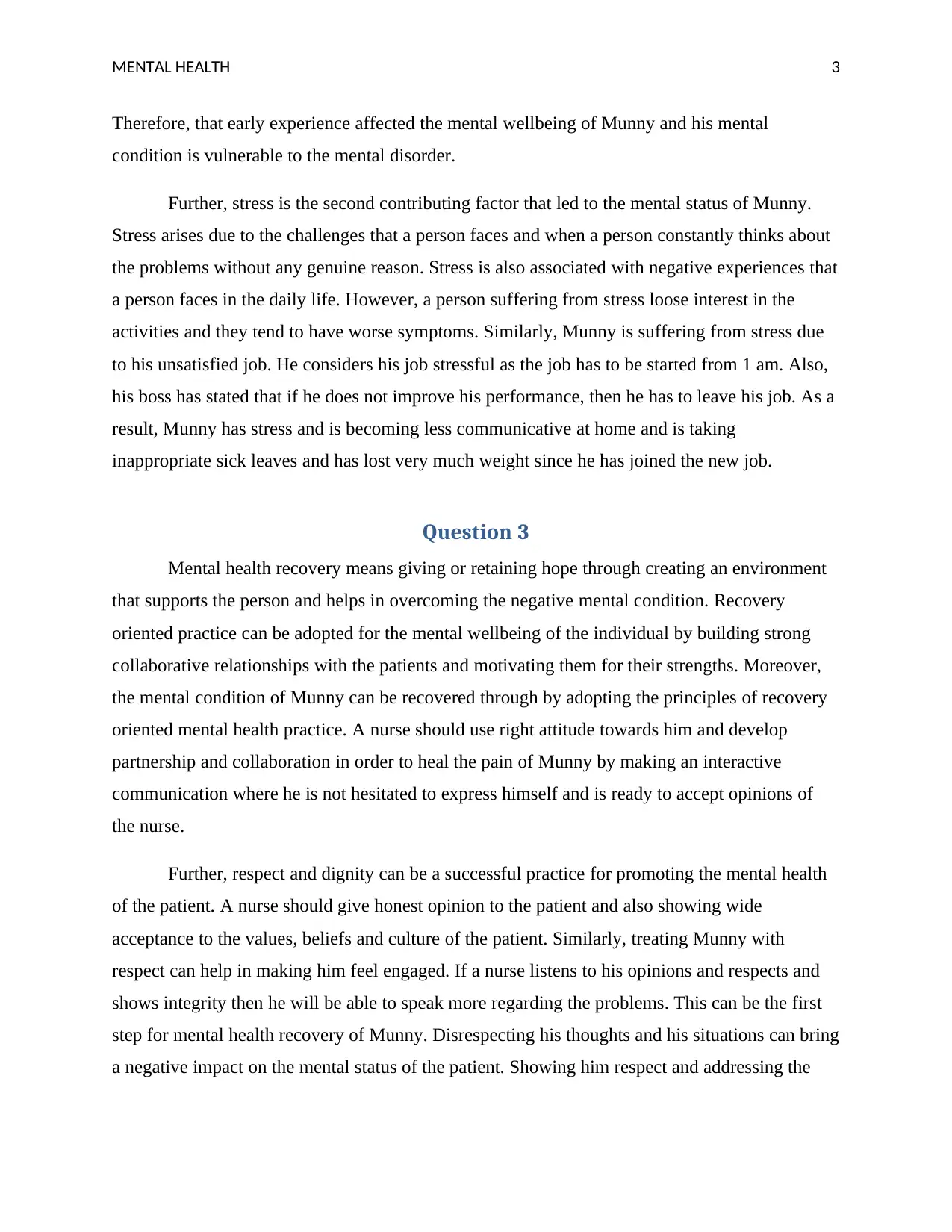
MENTAL HEALTH 3
Therefore, that early experience affected the mental wellbeing of Munny and his mental
condition is vulnerable to the mental disorder.
Further, stress is the second contributing factor that led to the mental status of Munny.
Stress arises due to the challenges that a person faces and when a person constantly thinks about
the problems without any genuine reason. Stress is also associated with negative experiences that
a person faces in the daily life. However, a person suffering from stress loose interest in the
activities and they tend to have worse symptoms. Similarly, Munny is suffering from stress due
to his unsatisfied job. He considers his job stressful as the job has to be started from 1 am. Also,
his boss has stated that if he does not improve his performance, then he has to leave his job. As a
result, Munny has stress and is becoming less communicative at home and is taking
inappropriate sick leaves and has lost very much weight since he has joined the new job.
Question 3
Mental health recovery means giving or retaining hope through creating an environment
that supports the person and helps in overcoming the negative mental condition. Recovery
oriented practice can be adopted for the mental wellbeing of the individual by building strong
collaborative relationships with the patients and motivating them for their strengths. Moreover,
the mental condition of Munny can be recovered through by adopting the principles of recovery
oriented mental health practice. A nurse should use right attitude towards him and develop
partnership and collaboration in order to heal the pain of Munny by making an interactive
communication where he is not hesitated to express himself and is ready to accept opinions of
the nurse.
Further, respect and dignity can be a successful practice for promoting the mental health
of the patient. A nurse should give honest opinion to the patient and also showing wide
acceptance to the values, beliefs and culture of the patient. Similarly, treating Munny with
respect can help in making him feel engaged. If a nurse listens to his opinions and respects and
shows integrity then he will be able to speak more regarding the problems. This can be the first
step for mental health recovery of Munny. Disrespecting his thoughts and his situations can bring
a negative impact on the mental status of the patient. Showing him respect and addressing the
Therefore, that early experience affected the mental wellbeing of Munny and his mental
condition is vulnerable to the mental disorder.
Further, stress is the second contributing factor that led to the mental status of Munny.
Stress arises due to the challenges that a person faces and when a person constantly thinks about
the problems without any genuine reason. Stress is also associated with negative experiences that
a person faces in the daily life. However, a person suffering from stress loose interest in the
activities and they tend to have worse symptoms. Similarly, Munny is suffering from stress due
to his unsatisfied job. He considers his job stressful as the job has to be started from 1 am. Also,
his boss has stated that if he does not improve his performance, then he has to leave his job. As a
result, Munny has stress and is becoming less communicative at home and is taking
inappropriate sick leaves and has lost very much weight since he has joined the new job.
Question 3
Mental health recovery means giving or retaining hope through creating an environment
that supports the person and helps in overcoming the negative mental condition. Recovery
oriented practice can be adopted for the mental wellbeing of the individual by building strong
collaborative relationships with the patients and motivating them for their strengths. Moreover,
the mental condition of Munny can be recovered through by adopting the principles of recovery
oriented mental health practice. A nurse should use right attitude towards him and develop
partnership and collaboration in order to heal the pain of Munny by making an interactive
communication where he is not hesitated to express himself and is ready to accept opinions of
the nurse.
Further, respect and dignity can be a successful practice for promoting the mental health
of the patient. A nurse should give honest opinion to the patient and also showing wide
acceptance to the values, beliefs and culture of the patient. Similarly, treating Munny with
respect can help in making him feel engaged. If a nurse listens to his opinions and respects and
shows integrity then he will be able to speak more regarding the problems. This can be the first
step for mental health recovery of Munny. Disrespecting his thoughts and his situations can bring
a negative impact on the mental status of the patient. Showing him respect and addressing the
Secure Best Marks with AI Grader
Need help grading? Try our AI Grader for instant feedback on your assignments.
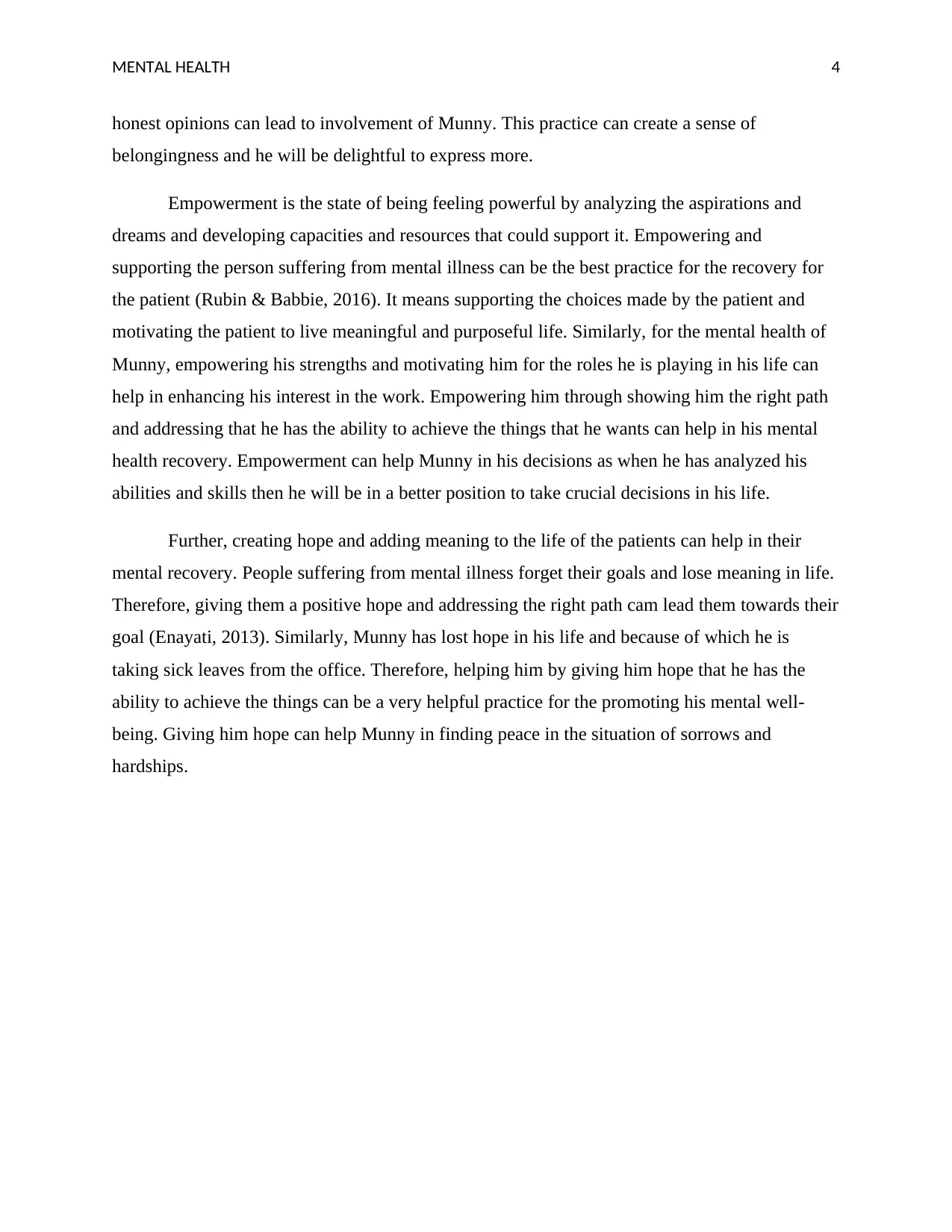
MENTAL HEALTH 4
honest opinions can lead to involvement of Munny. This practice can create a sense of
belongingness and he will be delightful to express more.
Empowerment is the state of being feeling powerful by analyzing the aspirations and
dreams and developing capacities and resources that could support it. Empowering and
supporting the person suffering from mental illness can be the best practice for the recovery for
the patient (Rubin & Babbie, 2016). It means supporting the choices made by the patient and
motivating the patient to live meaningful and purposeful life. Similarly, for the mental health of
Munny, empowering his strengths and motivating him for the roles he is playing in his life can
help in enhancing his interest in the work. Empowering him through showing him the right path
and addressing that he has the ability to achieve the things that he wants can help in his mental
health recovery. Empowerment can help Munny in his decisions as when he has analyzed his
abilities and skills then he will be in a better position to take crucial decisions in his life.
Further, creating hope and adding meaning to the life of the patients can help in their
mental recovery. People suffering from mental illness forget their goals and lose meaning in life.
Therefore, giving them a positive hope and addressing the right path cam lead them towards their
goal (Enayati, 2013). Similarly, Munny has lost hope in his life and because of which he is
taking sick leaves from the office. Therefore, helping him by giving him hope that he has the
ability to achieve the things can be a very helpful practice for the promoting his mental well-
being. Giving him hope can help Munny in finding peace in the situation of sorrows and
hardships.
honest opinions can lead to involvement of Munny. This practice can create a sense of
belongingness and he will be delightful to express more.
Empowerment is the state of being feeling powerful by analyzing the aspirations and
dreams and developing capacities and resources that could support it. Empowering and
supporting the person suffering from mental illness can be the best practice for the recovery for
the patient (Rubin & Babbie, 2016). It means supporting the choices made by the patient and
motivating the patient to live meaningful and purposeful life. Similarly, for the mental health of
Munny, empowering his strengths and motivating him for the roles he is playing in his life can
help in enhancing his interest in the work. Empowering him through showing him the right path
and addressing that he has the ability to achieve the things that he wants can help in his mental
health recovery. Empowerment can help Munny in his decisions as when he has analyzed his
abilities and skills then he will be in a better position to take crucial decisions in his life.
Further, creating hope and adding meaning to the life of the patients can help in their
mental recovery. People suffering from mental illness forget their goals and lose meaning in life.
Therefore, giving them a positive hope and addressing the right path cam lead them towards their
goal (Enayati, 2013). Similarly, Munny has lost hope in his life and because of which he is
taking sick leaves from the office. Therefore, helping him by giving him hope that he has the
ability to achieve the things can be a very helpful practice for the promoting his mental well-
being. Giving him hope can help Munny in finding peace in the situation of sorrows and
hardships.
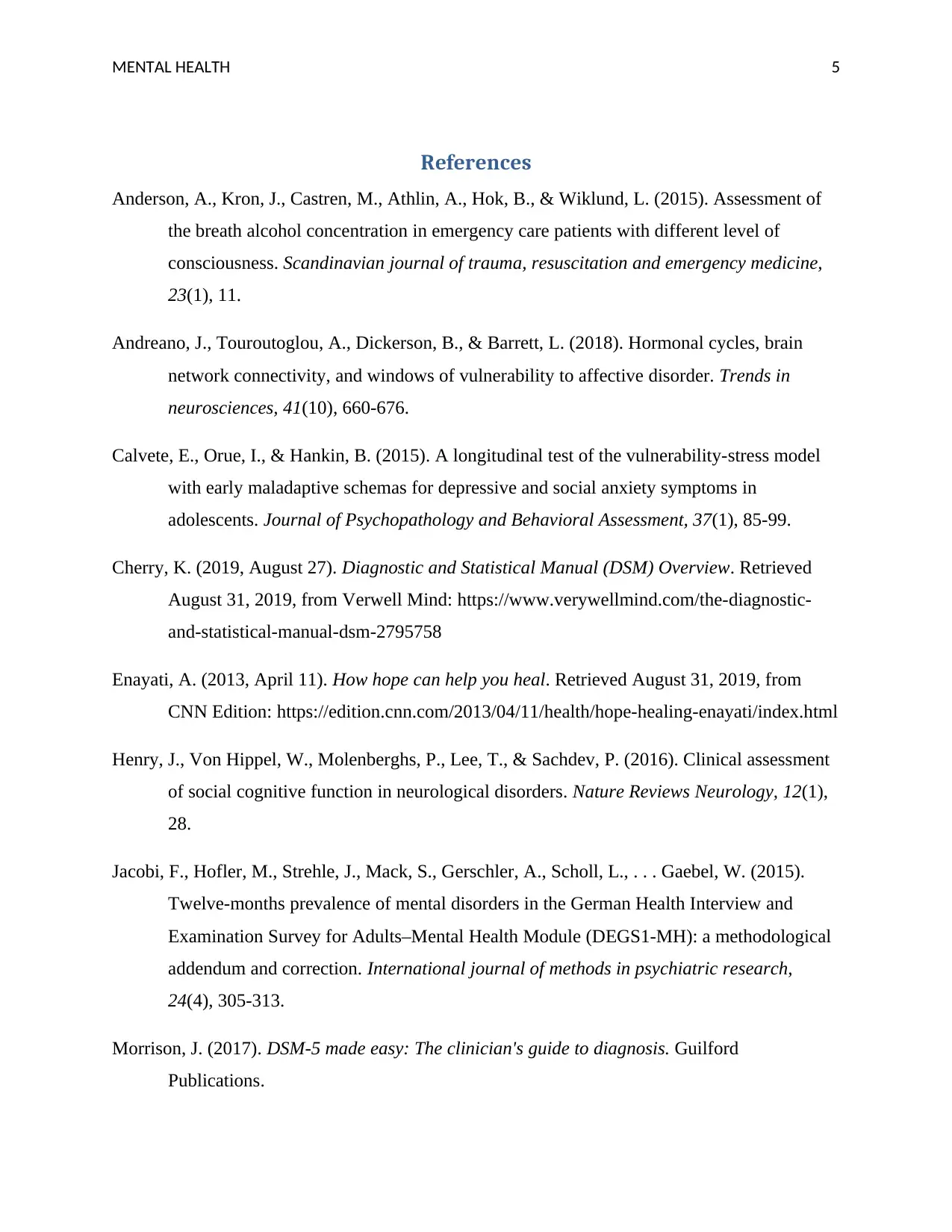
MENTAL HEALTH 5
References
Anderson, A., Kron, J., Castren, M., Athlin, A., Hok, B., & Wiklund, L. (2015). Assessment of
the breath alcohol concentration in emergency care patients with different level of
consciousness. Scandinavian journal of trauma, resuscitation and emergency medicine,
23(1), 11.
Andreano, J., Touroutoglou, A., Dickerson, B., & Barrett, L. (2018). Hormonal cycles, brain
network connectivity, and windows of vulnerability to affective disorder. Trends in
neurosciences, 41(10), 660-676.
Calvete, E., Orue, I., & Hankin, B. (2015). A longitudinal test of the vulnerability-stress model
with early maladaptive schemas for depressive and social anxiety symptoms in
adolescents. Journal of Psychopathology and Behavioral Assessment, 37(1), 85-99.
Cherry, K. (2019, August 27). Diagnostic and Statistical Manual (DSM) Overview. Retrieved
August 31, 2019, from Verwell Mind: https://www.verywellmind.com/the-diagnostic-
and-statistical-manual-dsm-2795758
Enayati, A. (2013, April 11). How hope can help you heal. Retrieved August 31, 2019, from
CNN Edition: https://edition.cnn.com/2013/04/11/health/hope-healing-enayati/index.html
Henry, J., Von Hippel, W., Molenberghs, P., Lee, T., & Sachdev, P. (2016). Clinical assessment
of social cognitive function in neurological disorders. Nature Reviews Neurology, 12(1),
28.
Jacobi, F., Hofler, M., Strehle, J., Mack, S., Gerschler, A., Scholl, L., . . . Gaebel, W. (2015).
Twelve‐months prevalence of mental disorders in the German Health Interview and
Examination Survey for Adults–Mental Health Module (DEGS1‐MH): a methodological
addendum and correction. International journal of methods in psychiatric research,
24(4), 305-313.
Morrison, J. (2017). DSM-5 made easy: The clinician's guide to diagnosis. Guilford
Publications.
References
Anderson, A., Kron, J., Castren, M., Athlin, A., Hok, B., & Wiklund, L. (2015). Assessment of
the breath alcohol concentration in emergency care patients with different level of
consciousness. Scandinavian journal of trauma, resuscitation and emergency medicine,
23(1), 11.
Andreano, J., Touroutoglou, A., Dickerson, B., & Barrett, L. (2018). Hormonal cycles, brain
network connectivity, and windows of vulnerability to affective disorder. Trends in
neurosciences, 41(10), 660-676.
Calvete, E., Orue, I., & Hankin, B. (2015). A longitudinal test of the vulnerability-stress model
with early maladaptive schemas for depressive and social anxiety symptoms in
adolescents. Journal of Psychopathology and Behavioral Assessment, 37(1), 85-99.
Cherry, K. (2019, August 27). Diagnostic and Statistical Manual (DSM) Overview. Retrieved
August 31, 2019, from Verwell Mind: https://www.verywellmind.com/the-diagnostic-
and-statistical-manual-dsm-2795758
Enayati, A. (2013, April 11). How hope can help you heal. Retrieved August 31, 2019, from
CNN Edition: https://edition.cnn.com/2013/04/11/health/hope-healing-enayati/index.html
Henry, J., Von Hippel, W., Molenberghs, P., Lee, T., & Sachdev, P. (2016). Clinical assessment
of social cognitive function in neurological disorders. Nature Reviews Neurology, 12(1),
28.
Jacobi, F., Hofler, M., Strehle, J., Mack, S., Gerschler, A., Scholl, L., . . . Gaebel, W. (2015).
Twelve‐months prevalence of mental disorders in the German Health Interview and
Examination Survey for Adults–Mental Health Module (DEGS1‐MH): a methodological
addendum and correction. International journal of methods in psychiatric research,
24(4), 305-313.
Morrison, J. (2017). DSM-5 made easy: The clinician's guide to diagnosis. Guilford
Publications.
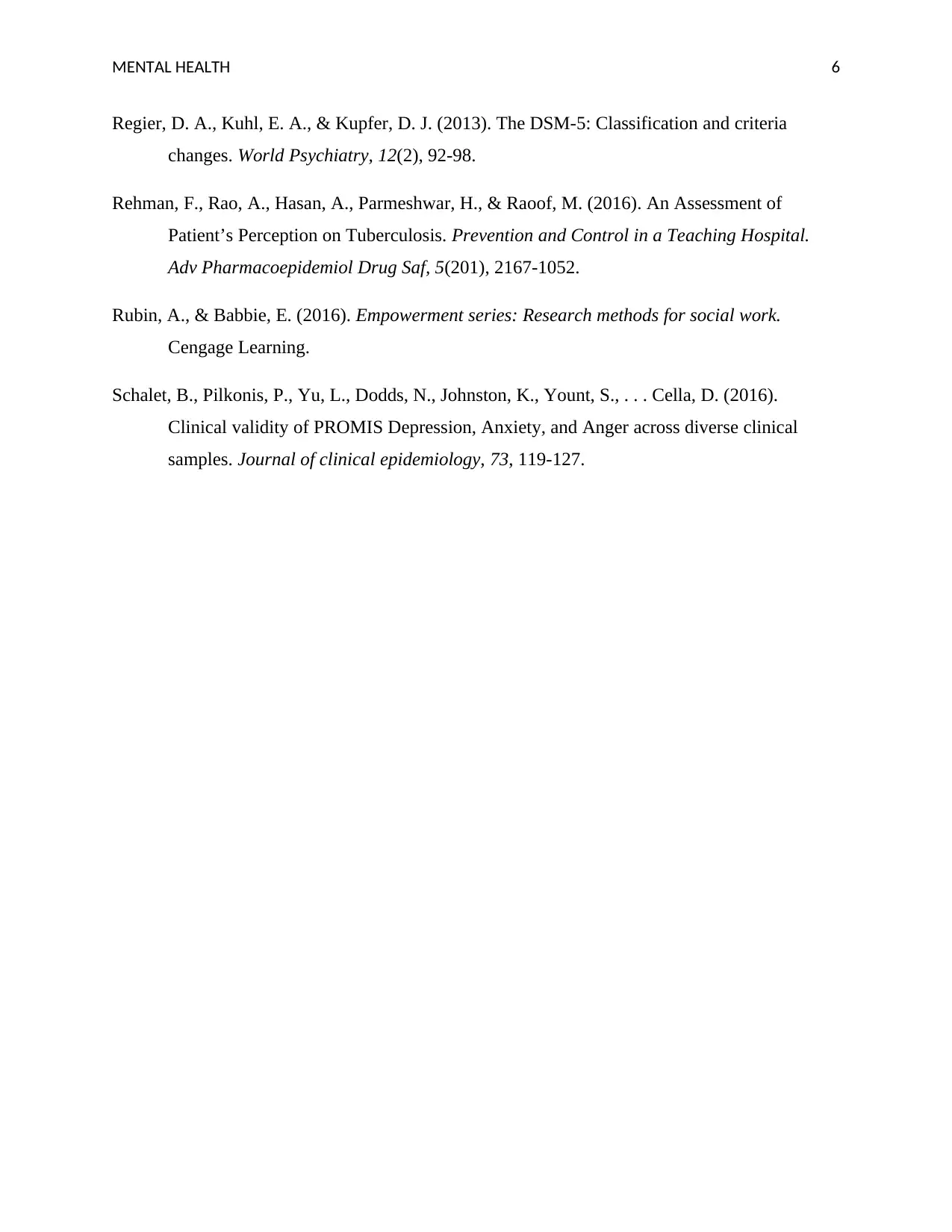
MENTAL HEALTH 6
Regier, D. A., Kuhl, E. A., & Kupfer, D. J. (2013). The DSM-5: Classification and criteria
changes. World Psychiatry, 12(2), 92-98.
Rehman, F., Rao, A., Hasan, A., Parmeshwar, H., & Raoof, M. (2016). An Assessment of
Patient’s Perception on Tuberculosis. Prevention and Control in a Teaching Hospital.
Adv Pharmacoepidemiol Drug Saf, 5(201), 2167-1052.
Rubin, A., & Babbie, E. (2016). Empowerment series: Research methods for social work.
Cengage Learning.
Schalet, B., Pilkonis, P., Yu, L., Dodds, N., Johnston, K., Yount, S., . . . Cella, D. (2016).
Clinical validity of PROMIS Depression, Anxiety, and Anger across diverse clinical
samples. Journal of clinical epidemiology, 73, 119-127.
Regier, D. A., Kuhl, E. A., & Kupfer, D. J. (2013). The DSM-5: Classification and criteria
changes. World Psychiatry, 12(2), 92-98.
Rehman, F., Rao, A., Hasan, A., Parmeshwar, H., & Raoof, M. (2016). An Assessment of
Patient’s Perception on Tuberculosis. Prevention and Control in a Teaching Hospital.
Adv Pharmacoepidemiol Drug Saf, 5(201), 2167-1052.
Rubin, A., & Babbie, E. (2016). Empowerment series: Research methods for social work.
Cengage Learning.
Schalet, B., Pilkonis, P., Yu, L., Dodds, N., Johnston, K., Yount, S., . . . Cella, D. (2016).
Clinical validity of PROMIS Depression, Anxiety, and Anger across diverse clinical
samples. Journal of clinical epidemiology, 73, 119-127.
1 out of 7
Related Documents
Your All-in-One AI-Powered Toolkit for Academic Success.
+13062052269
info@desklib.com
Available 24*7 on WhatsApp / Email
![[object Object]](/_next/static/media/star-bottom.7253800d.svg)
Unlock your academic potential
© 2024 | Zucol Services PVT LTD | All rights reserved.





